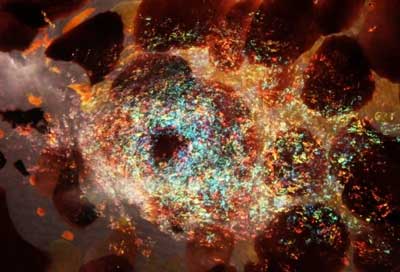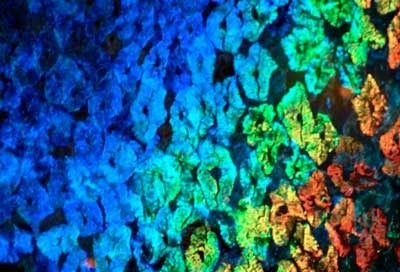| Nov 15, 2019 | |
A marvelous molecular machine(Nanowerk News) Squids, octopuses and cuttlefish are undisputed masters of deception and camouflage. Their extraordinary ability to change color, texture and shape is unrivaled, even by modern technology. |
|
| Researchers in the lab of UC Santa Barbara professor Daniel Morse have long been interested in the optical properties of color-changing animals, and they are particularly intrigued by the opalescent inshore squid. Also known as the California market squid, these animals have evolved the ability to finely and continuously tune their color and sheen to a degree unrivaled in other creatures. This enables them to communicate, as well as hide in plain sight in the bright and often featureless upper ocean. | |
 |
|
| This iridescent skin patch of the California market squid shows its dynamic iridocytes. The dark spots in the background are the pigment filled chromatophores. | |
| In previous work (Journal of Biological Chemistry, "Structures, Organization, and Function of Reflectin Proteins in Dynamically Tunable Reflective Cells"), the researchers uncovered that specialized proteins, called reflectins, control reflective pigment cells — iridocytes — which in turn contribute to changing the overall visibility and appearance of the creature. But still a mystery was how the reflectins actually worked. | |
| “We wanted now to understand how this remarkable molecular machine works,” said Morse, a Distinguished Emeritus Professor in the Department of Molecular, Cellular and Developmental Biology, and principal author of a paper that appears in the Journal of Biological Chemistry ("Calibration between trigger and color: Neutralization of a genetically encoded Coulombic switch and dynamic arrest precisely tune reflectin assembly"). Understanding this mechanism, he said, would provide insight into the tunable control of emergent properties, which could open the door to the next generation of bio-inspired synthetic materials. | |
Light-reflecting skin |
|
| Like most cephalopods, opalescent inshore squid, practice their sorcery by way of what may be the most sophisticated skin found anywhere in nature. Tiny muscles manipulate the skin texture while pigments and iridescent cells affect its appearance. One group of cells controls their color by expanding and contracting cells in their skin that contain sacks of pigment. | |
 |
|
| The adaptive iridocytes in the skin of the California market squid are able tune color through most of the spectrum. | |
| Behind these pigment cells are a layer of iridescent cells — those iridocytes — that reflect light and contribute to the animals’ color across the entire visible spectrum. The squids also have leucophores, which control the reflectance of white light. Together, these layers of pigment-containing and light-reflecting cells give the squids the ability to control the brightness, color and hue of their skin over a remarkably broad palette. | |
| Unlike the color from pigments, the highly dynamic hues of the opalescent inshore squid result from changing the iridocyte’s structure itself. Light bounces between nanometer-sized features about the same size as wavelengths in the visible part of the spectrum, producing colors. As these structures change their dimensions, the colors change. Reflectin proteins are behind these features’ ability to shapeshift, and the researchers’ task was to figure out how they do the job. | |
| Thanks to a combination of genetic engineering and biophysical analyses, the scientists found the answer, and it turned out to be a mechanism far more elegant and powerful than previously imagined. | |
| “The results were very surprising,” said first author Robert Levenson, a postdoctoral researcher in Morse’s lab. The group had expected to find one or two spots on the protein that controlled its activity, he said. “Instead, our evidence showed that the features of the reflectins that control its signal detection and the resulting assembly are spread across the entire protein chain.” | |
An Osmotic Motor |
|
| Reflectin, which is contained in closely packed layers of membrane in iridocytes, looks a bit like a series of beads on a string, the researchers found. Normally, the links between the beads are strongly positively charged, so they repel each other, straightening out the proteins like uncooked spaghetti. | |
| Morse and his team discovered that nerve signals to the reflective cells trigger the addition of phosphate groups to the links. These negatively charged phosphate groups neutralize the links’ repulsion, allowing the proteins to fold up. The team was especially excited to discover that this folding exposed new, sticky surfaces on the bead-like portions of the reflectin, allowing them to clump together. Up to four phosphates can bind to each reflectin protein, providing the squid with a precisely tunable process: The more phosphates added, the more the proteins fold up, progressively exposing more of the emergent hydrophobic surfaces, and the larger the clumps grow. | |
| As these clumps grow, the many, single, small proteins in solution become fewer, larger groups of multiple proteins. This changes the fluid pressure inside the membrane stacks, driving water out — a type of “osmotic motor” that responds to the slightest changes in charge generated by the neurons, to which patches of thousands of leucophores and iridocytes are connected. The resulting dehydration reduces the thickness and spacing of the membrane stacks, which shifts the wavelength of reflected light progressively from red to yellow, then to green and finally blue. The more concentrated solution also has a higher refractive index, which increases the cells’ brightness. | |
| “We had no idea that the mechanism we would discover would turn out to be so remarkably complex yet contained and so elegantly integrated in one multifunctional molecule — the block-copolymeric reflectin — with opposing domains so delicately poised that they act like a metastable machine, continually sensing and responding to neuronal signaling by precisely adjusting the osmotic pressure of an intracellular nanostructure to precisely fine-tune the color and brightness of its reflected light,” Morse said. | |
| What’s more, the researchers found, the whole process is reversible and cyclable, enabling the squid to continually fine-tune whatever optical properties its situation calls for. | |
New Design Principles |
|
| The researchers had successfully manipulated reflectin in previous experiments, but this study marks the first demonstration of the underlying mechanism. Now it could provide new ideas to scientists and engineers designing materials with tunable properties. “Our findings reveal a fundamental link between the properties of biomolecular materials produced in living systems and the highly engineered synthetic polymers that are now being developed at the frontiers of industry and technology,” Morse said. | |
| “Because reflectin works to control osmotic pressure, I can envision applications for novel means of energy storage and conversion, pharmaceutical and industrial applications involving viscosity and other liquid properties, and medical applications,” he added. | |
| Remarkably, some of the processes at work in these reflectin proteins are shared by the proteins that assemble pathologically in Alzheimer’s disease and other degenerative conditions, Morse observed. He plans to investigate why this mechanism is reversible, cyclable, harmless and useful in the case of reflectin, but irreversible and pathological for other proteins. Perhaps the fine-structured differences in their sequences can explain the disparity, and even point to new paths for disease prevention and treatment. |
| Source: UC Santa Barbara | |
|
Subscribe to a free copy of one of our daily Nanowerk Newsletter Email Digests with a compilation of all of the day's news. |
